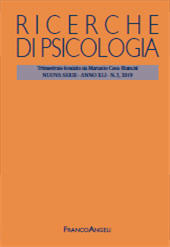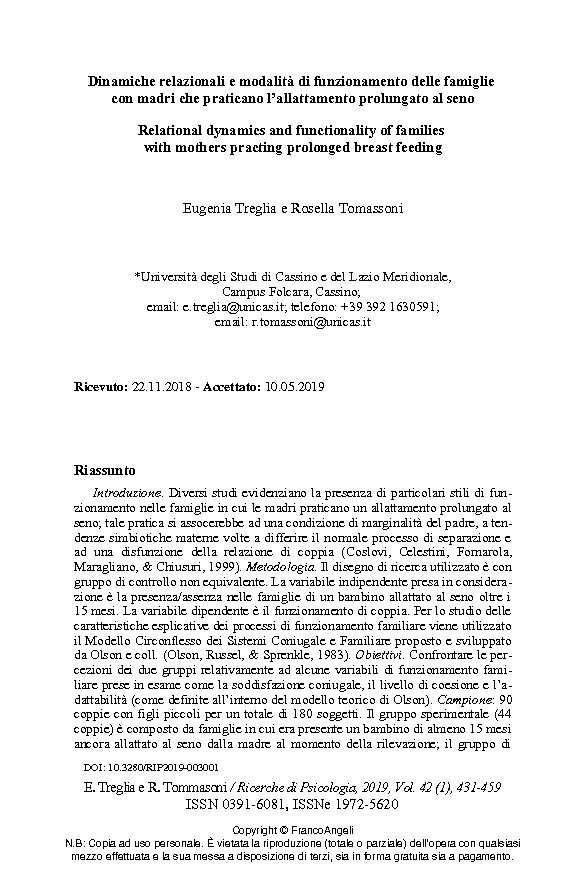Dinamiche relazionali e modalità di funzionamento delle famiglie con madri che praticano l'allattamento prolungato al seno
431-459 p.
Introduzione. Diversi studi evidenziano la presenza di particolari stili di funzionamento nelle famiglie in cui le madri praticano un allattamento prolungato al seno; tale pratica si assocerebbe ad una condizione di marginalità del padre, a tendenze simbiotiche materne volte a differire il normale processo di separazione e ad una disfunzione della relazione di coppia (Coslovi, Celestini, Fornarola, Maragliano, & Chiusuri, 1999). Metodologia. Il disegno di ricerca utilizzato è con gruppo di controllo non equivalente. La variabile indipendente presa in considerazione è la presenza/assenza nelle famiglie di un bambino allattato al seno oltre i 15 mesi. La variabile dipendente è il funzionamento di coppia. Per lo studio delle caratteristiche esplicative dei processi di funzionamento familiare viene utilizzato il Modello Circonflesso dei Sistemi Coniugale e Familiare proposto e sviluppato da Olson e coll. (Olson, Russel, & Sprenkle, 1983). Obiettivi. Confrontare le percezioni dei due gruppi relativamente ad alcune
variabili di funzionamento familiare prese in esame come la soddisfazione coniugale, il livello di coesione e l'adattabilità (come definite all'interno del modello teorico di Olson). Campione: 90 coppie con figli piccoli per un totale di 180 soggetti. Il gruppo sperimentale (44 coppie) è composto da famiglie in cui era presente un bambino di almeno 15 mesi ancora allattato al seno dalla madre al momento della rilevazione; il gruppo di controllo (46 coppie) è costituito da famiglie con bambini svezzati entro il primo anno di vita. Strumenti. Ad entrambi i membri della coppia è stato somministrato un questionario per la raccolta di dati anagrafici e il Questionario Family Adaptability and Cohesion Evaluation Scales (FACES III, 1985) nelle sue due versioni Reale ed Ideale per indagare il funzionamento di coppia. Risultati. L'analisi delle frequenze mostra che la percentuale di coppie che rientra nelle tipologie estreme di funzionamento previste dal modello è maggiore nel gruppo sperimentale (27%) rispetto al
gruppo di controllo (13%). All'interno del gruppo di controllo non vi sono coppie che si collocano sul versante del disimpegno, mentre tale tipologia raggiunge nel gruppo sperimentale una frequenza complessiva del 22,6%. Nel gruppo sperimentale la tipologia invischiata/caotica è maggiormente rappresentata raggiungendo una frequenza del 18,2% a fronte del 13% osservato nelle coppie del gruppo controllo. L'analisi della varianza rileva una differenza statisticamente significativa tra i punteggi medi dei due gruppi nella dimensione della coesione reale (F = 4,780; p < 0,031) con un punteggio medio maggiore nel gruppo di controllo (M = 42.00; DS = 4.222) rispetto al gruppo sperimentale (M = 39,43; DS = 6,697). Anche la differenza tra i Punteggi di Discrepanza o Soddisfazione Familiare tra i due gruppi considerati raggiunge la significatività statistica (F = 5,121; p < 0,026) ed osservando le medie si rileva un Punteggio medio di Discrepanza più alto nelle coppie del gruppo sperimentale (M = 8,32; DS =
rispetto ai controlli (M = 2,37; DS = 10,184) il che denoterebbe un livello di insoddisfazione coniugale più alto nelle coppie del gruppo sperimentale. Si evidenzia una differenza statisticamente significativa, all'interno del gruppo sperimentale, anche tra i punteggi medi di uomini e donne nella dimensione dell'Adattabilità Ideale (F = 0,047; p < 0,047) presentando le donne di questo gruppo un punteggio medio più alto (M = 40,68; DS = 5,037) rispetto agli uomini (M = 36,50; DS = 8,146). Dall'analisi correlazionale emerge, all'interno del gruppo sperimentale, una relazione lineare di tipo negativo tra il punteggio di Soddisfazione Familiare e l'età dei bambini (r = -0,462) che rivela una diminuzione della soddisfazione familiare all'aumentare dell'età dei bambini. Nel gruppo di controllo invece si evidenzia una relazione statisticamente significativa tra la durata del matrimonio ed il punteggio di Soddisfazione familiare (r = 0,44) che indica come all'aumentare della durata del matrimonio aumenti
contemporaneamente la soddisfazione coniugale. Discussione e Conclusione. I dati evidenziano nelle famiglie con madri lungoallattanti una tendenza maggiore a collocarsi agli estremi del modello di Olson. Per le coppie del gruppo sperimentale collocatesi nella tipologia estrema invischiata/caotica (18,2%) si può ipotizzare una difficile transizione alla genitorialità, una scarsa differenziazione tra i coniugi e tendenze simbiotiche e coesive che si estenderebbero anche al bambino e che giustificherebbero il ricorso all'allattamento prolungato al seno. Per le coppie che si collocano invece sul versante del disimpegno si può ipotizzare una distanza affettiva e uno scarso coinvolgimento del coniuge nella cura del figlio, che diviene quindi oggetto di iperinvestimento affettivo da parte delle madri. L'analisi dei dati ha evidenziato inoltre che il gruppo con madri lungoallattanti sperimenta livelli più alti di insoddisfazione nella relazione coniugale rispetto al gruppo di controllo; le madri lungoallattanti
in oltre punteggi medi più bassi rispetto agli uomini dello stesso gruppo nella dimensione della soddisfazione coniugale. La scarsa soddisfazione nella relazione di coppia potrebbe spingere queste madri a fare un uso compensativo dell'allattamento al seno. I risultati dell'analisi correlazionale risultano in linea con i dati e le ipotesi finora considerate. Le coppie con madri lungoallattanti sperimentano difatti una minore soddisfazione coniugale all'aumentare dell'età dei bambini. Nelle coppie con bambini regolarmente svezzati si osserva invece come all'aumentare della durata del matrimonio aumenti contemporaneamente la soddisfazione coniugale. [Testo dell'editore].
Introduction. Several studies highlight the presence of particular functioning styles in families where mothers practice prolonged breastfeeding; this practice would be associated with a condition of father's marginality, with maternal symbiotic tendencies to defer the normal process of separation and to a dysfunction of the couple relationship (Coslovi, Celestini, Fornarola, Maragliano, & Chiusuri, 1999). Methodology. The research design used is with a non-equivalent control group, since the subjects are not randomly assigned to the two groups but on the basis of pre-existing characteristics (McBurney, 1996). The independent variable taken into consideration is the presence / absence in families of a breast-fed child over 15 months. The dependent variable is the functioning of the couple. For the study of the explanatory characteristics of the family functioning processes we have used the Circumflex Model of the Conjugal and Family Systems proposed and developed by Olson et al. (Olson, Russell, & Sprenkle,
1983). Aims. To compare the perceptions of the two groups with regard to some variables of family functioning examined as marital satisfaction, the level of cohesion and adaptability (as defined within the theoretical model of Olson). Sample: 90 couples with young children took part in the study for a total of 180 subjects. The experimental group (44 couples) is composed of families in which there is a toddler of at least 15 months still breastfed by the mother; the control group (46 couples) is made up of families with children weaned within the first year of life (46 couples). Tools. Both members of the couple were given a questionnaire for the collection of personal data and the Family Adaptability and Cohesion Evaluation Scales Questionnaire (FACES III, 1985) in its two Real and Ideal versions to investigate the functioning of the couple. Results. The analysis of the frequencies shows that the percentage of couples that falls within the extreme types of functioning provided by the model is greater in
experimental group (27%) than in the control group (13%). Within the control group there are no couples that are on the disengagement side, while this type reaches a total frequency of 22.6% in the experimental group. In the experimental group the Invised / chaotic type is most represented reaching a frequency of 18.2% compared to 13% observed in the control group pairs. The analysis of variance reveals a statistically significant difference between the mean scores of the two groups in the real cohesion dimension (F = 4.780; p <0.031) with a higher mean score in the control group (M = 42.00; SD = 4.222) compared to the group experimental (M = 39.43; SD = 6.697). Also the difference between the Scores of Discrepancy or Family Satisfaction between the two considered groups reaches statistical significance (F = 5.121; p <0.026) and observing the averages we find a higher average Discrepancy score in the pairs of the experimental group (M = 8.32 SD = 14.475) compared to controls (M = 2.37 SD = 10.184),
would indicate a higher level of marital dissatisfaction in the pairs of the experimental group. There is a statistically significant difference, within the experimental group, also between the average scores of men and women in the ideal adaptability dimension (F = 0.047; p <0.047) presenting the women of this group a higher average score ( M = 40.68; SD = 5.037) compared to men (M = 36.50; DS = 8.146). Correlational analysis reveals, within the experimental group, a negative linear relationship between the Family Satisfaction score and the age of the children (r = -0.462) which indicates a decrease in family satisfaction with the increase in the age of the children. In the control group, on the other hand, there is a statistically significant relationship between the duration of the marriage and the score of family satisfaction (r = 0.44) which indicates how the increase in the duration of the marriage increases conjugal satisfaction at the same time. Discussion and Conclusion. The data show that in
families with prolonged breastfeeding mothers, there is a greater tendency to place themselves at the extremes of the Olson model and therefore to have more difficulty adapting to changes during the life cycle. These families have a combination of low / high cohesion with low / high adaptability. For the couples of the experimental group that are in the extreme type of enmeshed/chaotic (18.2%) we can hypothesize a difficult transition to parenthood, a poor differentiation between spouses and symbiotic and cohesive tendencies that would also extend to the child and that would justify the use of prolonged breastfeeding. For couples who are instead on the side of disengagement we can hypothesise an emotional distance and a poor involvement of the spouse in the care of the child, which then becomes the object of affective hyper-investment by the mothers. The analysis of the data also showed that the group with prolonged breastfeeding mothers experiences higher levels of dissatisfaction in the marital
compared to the control group; these mothers also have lower average scores than men of the same group in the dimension of marital satisfaction. The lack of satisfaction in the couple relationship could push these mothers to make compensatory use of breastfeeding. The results of the correlational analysis are in line with the data. In fact couples with prolonged breastfeeding mothers experience less marital satisfaction as the age of the children increases. On the other hand, in couples with regularly weaned children, marital satisfaction is increased at the same time as the duration of marriage increases. [Publisher's text].
Is part of
Ricerche di psicologia : 3, 2019-
Articles from the same issue (available individually)
-
-
Information
ISSN: 1972-5620
KEYWORDS
- Allattamento prolungato, funzionamento di coppia, soddisfazione coniugale, tendenze simbiotiche
- Prolonged breastfeeding, couples functioning, marital satisfaction, symbiotic tendencies



